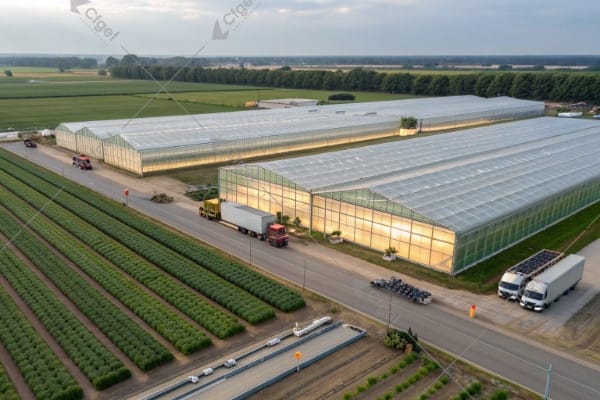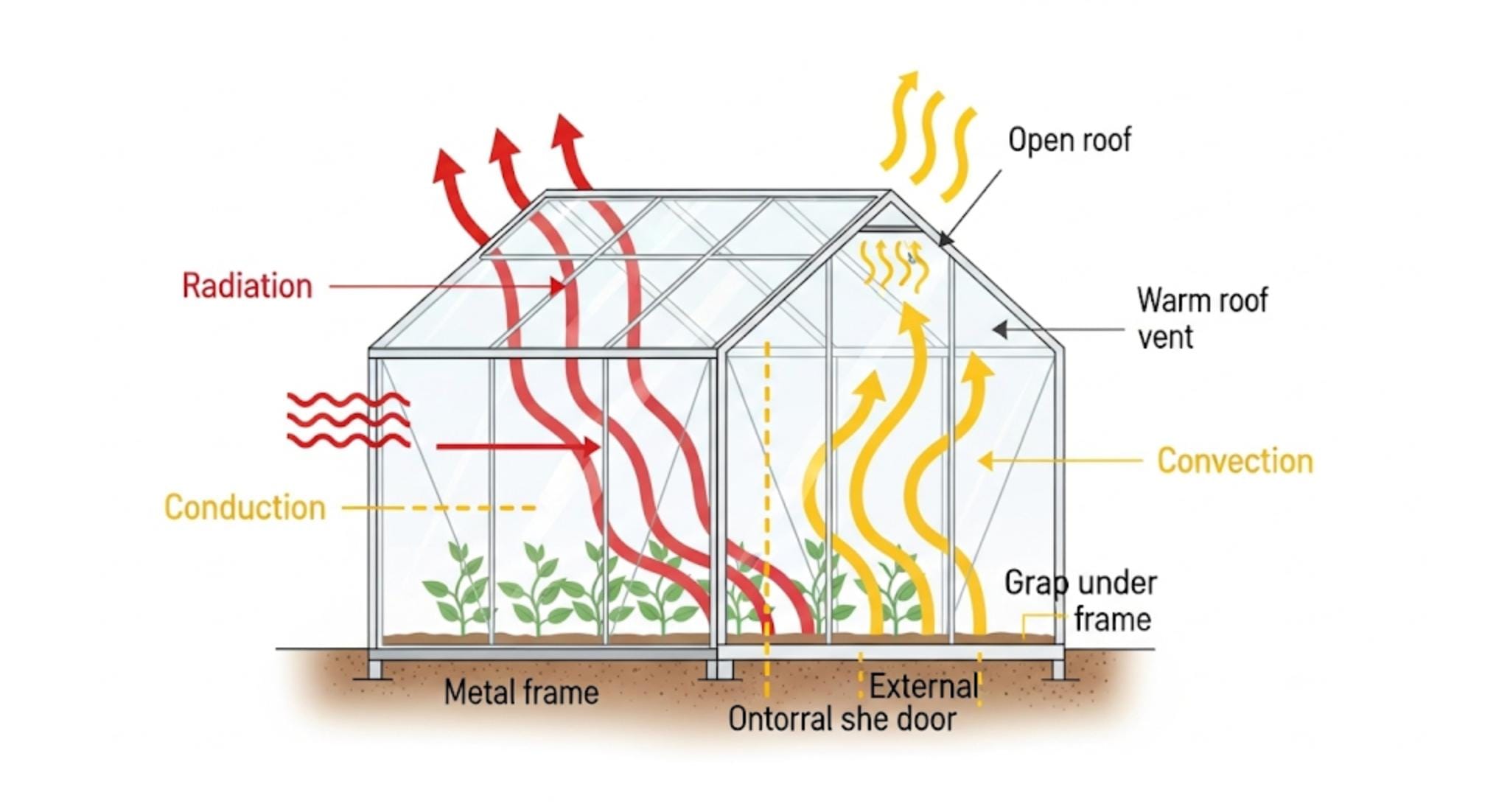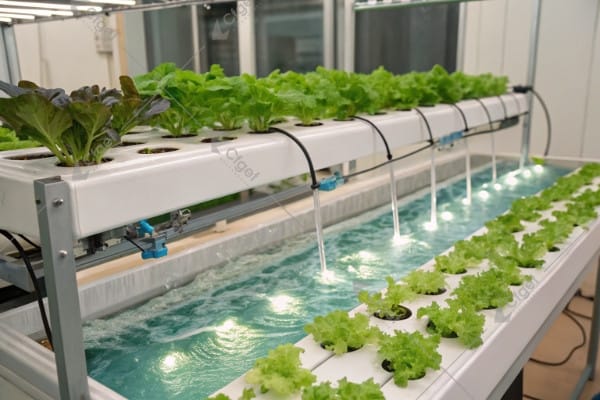Winter can devastate your greenhouse crops, with temperatures plummeting to dangerous levels overnight. Many growers struggle with energy costs while trying to maintain optimal growing conditions during cold months.
Increasing greenhouse temperatures effectively requires a combination of proper insulation materials and efficient heating methods. By implementing strategic solutions like thermal blankets, foam boards, soil heat storage, and active heating systems, growers can maintain optimal temperatures while managing energy costs.
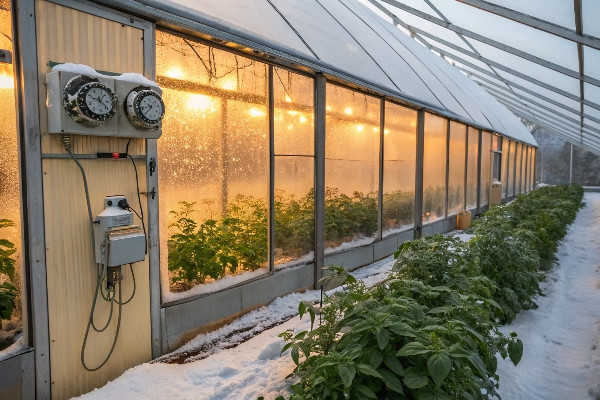
After 28 years in the greenhouse industry, I’ve learned that temperature management is the foundation of successful winter cultivation. Each year, our clients across different climate zones face this challenge, but with the right approach, winter growing becomes not just possible but profitable.
Don’t Miss:——Exploring Greenhouse Types: Finding the Perfect Structure for Your Needs
You might like:——Mastering Strawberry Greenhouse Cultivation: Best Practices for Optimal Growth?
Applying Simple Insulation Materials: Foam Boards, Thermal Blankets, and Plastic Films?
Winter heat loss happens rapidly in poorly insulated greenhouses, leaving plants vulnerable to cold damage. I’ve seen growers waste thousands on heating systems that simply can’t keep up with heat escaping through inadequate insulation.
Effective greenhouse insulation starts with selecting appropriate materials based on your structure type and climate conditions. Foam boards provide rigid insulation for walls, while thermal blankets create overnight heat retention, and double-layer plastic films with air gaps reduce heat transfer by up to 40% compared to single layers.
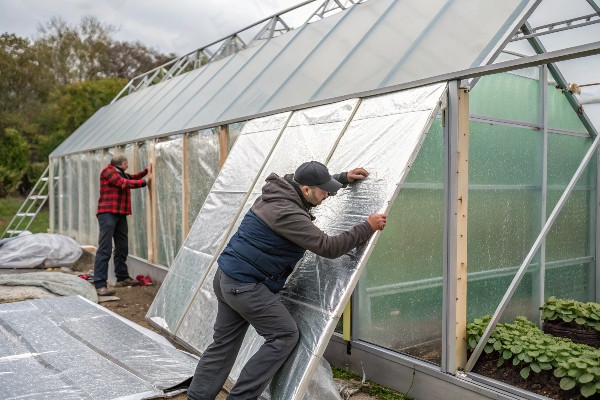
Insulation materials form the first line of defense against winter cold, and their proper selection can dramatically reduce heating costs while maintaining stable temperatures. When I worked with a client in Northern Europe, we discovered that proper insulation alone reduced their heating costs by 30%.
Material Comparison for Different Greenhouse Types
The effectiveness of insulation materials varies depending on your greenhouse structure and local climate conditions:
Foam Board Insulation
Foam boards, typically made from polystyrene or polyisocyanurate, offer excellent thermal resistance (R-value) for greenhouse walls and foundation perimeters. For glass or polycarbonate greenhouses, I recommend installing foam board insulation around the lower perimeter walls where heat loss is most significant. One client in Germany lined their greenhouse foundation with 2-inch foam board insulation, creating a thermal break between the ground and structure. This simple addition prevented the constant heat drain into the cold soil and reduced their heating requirements significantly.
Thermal Blankets and Energy Curtains
Thermal blankets represent one of the most cost-effective solutions for overnight temperature maintenance. These specialized fabrics, often made from aluminum-coated materials, can be deployed manually or with automated systems to create an insulating layer above crops after sunset. Many of our commercial clients use automated curtain systems that open during the day to allow maximum light penetration and close at night to trap heat. A research institution we worked with in Finland documented temperature differences of up to 8°C (14°F) between areas with and without thermal blankets on cold winter nights.
Plastic Film Innovations
Double or even triple-layer plastic films with air gaps between layers have revolutionized greenhouse insulation. The trapped air serves as an excellent insulator, while newer film formulations include infrared inhibitors that prevent heat radiation from escaping. For film greenhouses in extreme climates, we now recommend films with nanobubble technology that provides superior insulation while maintaining light transmission. Last winter, we retrofitted a client’s greenhouse in Poland with this technology, allowing them to grow cold-sensitive ornamentals throughout winter while using 25% less heating energy.
| Insulation Type | R-Value Range | Installation Complexity | Lifespan | Best For |
|---|---|---|---|---|
| Foam Boards | 3.8-6.5 per inch | Moderate | 20+ years | Permanent structures |
| Thermal Blankets | 1.5-3.0 total | Low to Moderate | 3-5 years | Overnight insulation |
| Double Plastic Film | 1.5-2.0 total | Low | 3-4 years | Cost-effective coverage |
| IR-Treated Films | 2.0-2.5 total | Low | 3-4 years | Radiation heat retention |
Utilizing Natural Heat Sources: Soil Heat Storage and Greenhouse-Livestock Integrated Systems?
Relying solely on artificial heating drains resources and creates unsustainable growing operations. Many growers miss the opportunity to leverage natural heat sources that could significantly reduce their energy consumption.
Natural heat sources can substantially reduce greenhouse heating costs through strategic implementations. Soil heat storage systems capture daytime warmth in water tanks or stone beds for nighttime release, while integrated greenhouse-livestock systems utilize animal body heat and CO2 production to benefit plant growth.
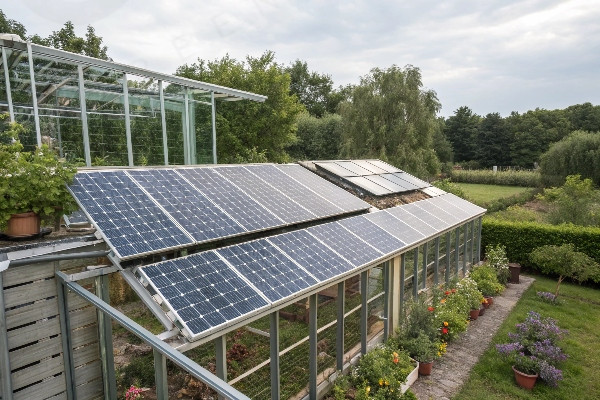
When designing greenhouse heating systems, I always start by exploring how we can leverage natural energy flows before adding active heating components. This approach has proven both economically and environmentally superior across diverse climate zones.
Harnessing Earth’s Thermal Mass
The soil beneath and surrounding a greenhouse represents an enormous thermal battery that can be strategically utilized for temperature regulation. In our projects across Central Asia, where temperature swings between day and night can be extreme, we’ve implemented several soil heat storage systems with remarkable results.
One particularly effective approach involves installing a network of perforated pipes approximately 3-4 feet below the greenhouse floor. During warm daylight hours, fans circulate the hot greenhouse air through these underground pipes, gradually warming the soil mass. As night temperatures fall, this stored heat radiates back into the greenhouse, providing several degrees of temperature moderation without any additional energy input. For a commercial tomato operation in Kazakhstan, this system maintained nighttime temperatures 4-5°C higher than outside ambient conditions throughout much of winter.
Water tanks painted black and positioned along north-facing walls similarly capture and store solar energy during the day. The high specific heat capacity of water makes it an excellent thermal battery. In a research project we conducted in Thailand, 55-gallon drums filled with water and placed strategically throughout the greenhouse provided sufficient nighttime temperature moderation for tropical plant production even during cooler winter months.
Integrated Biological Systems
Some of the most interesting natural heating approaches involve biological integration – particularly livestock-greenhouse combinations. These systems capitalize on the natural heat and CO2 produced by animals to benefit plant growth while creating multiple revenue streams for growers.
In Mongolia, we helped design a greenhouse with an attached chicken coop separated by a shared insulated wall. Heat from the approximately 50 chickens was ducted into the greenhouse during winter nights, providing supplemental warmth while also enriching the growing environment with CO2. The greenhouse vegetables thrived on the enhanced atmosphere, while plant waste provided supplemental feed for the chickens – a true symbiotic relationship.
Another fascinating project involved rabbit hutches positioned directly within a greenhouse in northern China. The rabbits generated significant body heat while producing valuable fertilizer for the growing beds. The owner reported fuel savings of approximately 30% compared to similar standalone greenhouses in the region.
| Natural Heat Source | Temperature Impact | Implementation Cost | Maintenance | Complementary Benefits |
|---|---|---|---|---|
| Underground Pipe System | +3-7°C at night | High | Low | Long-term soil warming |
| Water Thermal Mass | +2-5°C at night | Low to Moderate | Minimal | Humidity regulation |
| Chicken Integration | +2-4°C | Moderate | Daily | CO2 enrichment, multiple products |
| Rabbit Integration | +1-3°C | Low | Daily | Direct fertilization, multiple products |
Comparing Active Heating Systems: Hot Air Blowers, Solar Collectors, and Smart Controls?
Winter greenhouse operation often fails due to inappropriate or inefficient active heating systems. I’ve consulted for numerous operations where poorly matched heating technology resulted in both crop failure and excessive energy costs.
Selecting the right active heating system depends on greenhouse size, crop requirements, and available resources. Hot air systems provide quick temperature increases but create uneven distribution, while hydronic systems offer consistent heat through radiation. Solar collectors can supplement conventional systems, and smart controls optimize energy usage by up to 30%.

After addressing insulation and natural heat sources, selecting the appropriate active heating technology becomes critical for successful winter greenhouse operation. The right system depends on multiple factors including climate severity, crop requirements, and available fuel sources.
Hot Air Systems: Rapid Response with Challenges
Forced-air heating remains common in many greenhouse operations due to relatively low installation costs and rapid temperature response. These systems typically use propane, natural gas, or electrical heaters with fans to distribute heated air throughout the growing space. For smaller operations or in situations requiring quick temperature adjustment, forced air systems offer distinct advantages.
However, my experience with numerous clients has revealed significant limitations to hot air systems. Temperature stratification – where hot air accumulates near the ceiling while plant-level temperatures remain too low – presents a persistent challenge. During a consulting visit to a flower operation in Estonia, we measured temperature differences of over 9°C between floor and ceiling levels using standard unit heaters. This resulted in uneven crop development and significant energy waste.
Distribution challenges with forced air also create problematic microclimates throughout larger greenhouses. To overcome these limitations, we now typically recommend horizontal air flow (HAF) fans1 to work in conjunction with unit heaters. In a recent project in Vietnam, installing a calculated pattern of HAF fans reduced temperature variation across the growing area from 7°C to just 2°C, dramatically improving crop uniformity.
Hydronic Systems: Consistent Performance at Higher Cost
For premium growing operations, hydronic (water-based) heating systems provide superior temperature consistency and plant-level warmth. These systems circulate heated water through pipes positioned at crop level or embedded in growing benches, delivering radiant heat directly to the plant environment.
The advantages of hydronic heating became clear during a consulting project for an orchid producer in the Netherlands. By replacing their forced air system with bench-top hydronic tubing, they reduced energy consumption by 22% while simultaneously improving plant quality and bloom consistency. The radiant heat created ideal root-zone temperatures without wasting energy heating the entire air volume of the greenhouse.
Modern innovations in hydronic greenhouse heating include low-profile aluminum rail systems that combine plant support functions with heating. These multi-purpose installations maximize usable growing space while providing exceptionally uniform heat distribution. For premium crop production where temperature consistency directly impacts quality and marketability, hydronic systems typically offer the best return on investment despite higher initial costs.
Smart Control Integration
The efficiency of any heating system ultimately depends on its control technology. Smart greenhouse controllers that integrate multiple environmental parameters have transformed winter growing in recent years. During a major retrofit project in Finland, we replaced basic thermostatic controls with a smart system that incorporated light levels, humidity, CO2 concentration, and outside weather conditions into its heating algorithm.
The results were remarkable – energy consumption decreased by 31% while plant quality improved. The system anticipated weather changes based on forecasting data and adjusted heating patterns accordingly, preventing the temperature fluctuations that had previously stressed crops. The return on investment period for the control upgrade was just 14 months – far shorter than the grower had anticipated.
| Heating System | Initial Cost | Energy Efficiency | Heat Distribution | Ideal Application |
|---|---|---|---|---|
| Unit Heaters (Forced Air) | Low | Moderate | Poor to Fair | Small structures, temporary heating |
| Hydronic Floor/Bench | High | Excellent | Excellent | Premium crops, long-term operation |
| Infrared Radiant | Moderate | Good | Good (direct) | Zonal heating, targeted growing areas |
| Combination Systems | High | Very Good | Very Good | Large commercial operations |
| Smart Controls (any system) | Moderate | Improves existing by 15-30% | Improves existing | All professional operations |
Windbreak Strategies: Building Effective Wind Barriers for Your Greenhouse?
Wind dramatically accelerates heat loss from greenhouses, yet many growers underestimate its impact on temperature stability and heating costs. Even well-insulated structures suffer when exposed to persistent cold winds.
Strategic windbreaks can reduce greenhouse heating requirements by 5-30% depending on local conditions. Natural windbreaks using evergreen trees provide long-term protection, while structural barriers offer immediate benefits. Properly designed wind barriers should filter wind rather than block it completely to prevent turbulence.
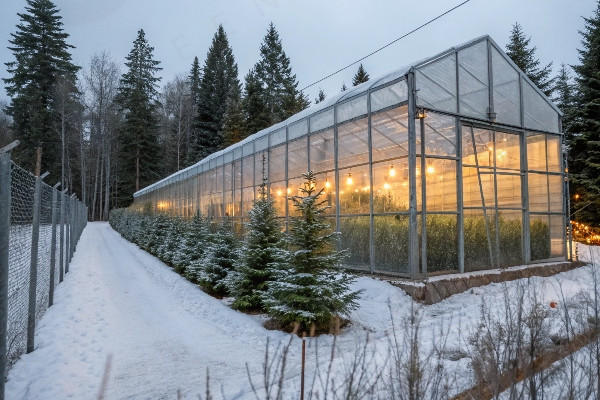
Wind protection represents one of the most overlooked aspects of greenhouse temperature management. Throughout my career consulting on greenhouse projects worldwide, I’ve consistently found that effective wind management delivers exceptional returns on investment in cold climates.
Understanding Wind’s Impact on Heat Loss
The physics of wind-accelerated heat loss are straightforward but often underappreciated in greenhouse design. Wind increases heat loss through both convection (as moving air carries away heat from exterior surfaces) and infiltration (as pressure differences force cold air through small openings). Our testing in various climate zones has shown that greenhouses exposed to persistent winter winds can require up to 40% more heating energy than identical structures in protected locations.
In a particularly striking example, we monitored two identical greenhouse operations in central Poland – one with comprehensive wind protection and one fully exposed. During January operations, the protected greenhouse consistently required 27% less heating energy while maintaining identical internal temperatures. This difference represented thousands of dollars in operational savings over just a single winter season.
The relationship between wind speed and heat loss isn’t linear – even modest wind reductions yield significant benefits. Our data shows that reducing average wind velocity by half typically reduces heating costs by approximately 30%, making windbreak structures one of the highest-return investments for winter greenhouse operation.
Natural Windbreak Solutions
Natural windbreaks, particularly evergreen trees and shrubs, offer excellent long-term wind protection while providing ecological benefits. The ideal natural windbreak creates a semi-permeable barrier that filters wind rather than blocking it completely – this prevents the turbulence and downdrafts that solid barriers can create.
When designing natural windbreaks for commercial greenhouse operations, we typically recommend a multi-row approach with plants of varying heights. For a client in Romania, we designed a three-row windbreak using Norway spruce, with trees planted in a staggered pattern at 2-meter intervals. This configuration provided excellent protection once established, reducing wind speed by approximately 60% at the greenhouse location while avoiding problematic turbulence.
The primary limitation of natural windbreaks is establishment time – most evergreen species require 3-7 years to provide significant protection. For this reason, we often recommend combining natural windbreaks with temporary structural solutions during the establishment phase.
Structural Wind Barriers
For immediate wind protection, structural barriers offer excellent results when properly designed. Semi-permeable barriers constructed from materials with 50-60% porosity typically perform better than solid walls, which can create turbulent air patterns on their leeward side. Materials like commercial windbreak netting, slatted fencing, or purpose-designed wind panels provide ideal filtration characteristics.
In a project for a greenhouse complex in northern Kazakhstan, where winter winds regularly exceed 40 mph, we installed a system of engineered windbreak panels positioned 15 meters upwind of the main greenhouse range. These panels reduced wind velocity by approximately 65% while avoiding the turbulence problems that had occurred with a previous solid barrier design. The greenhouse operation reported heating cost reductions of 22% compared to previous winters.
| Windbreak Type | Wind Reduction | Establishment Time | Lifespan | Secondary Benefits |
|---|---|---|---|---|
| Evergreen Trees (3 rows) | 60-80% | 5-10 years | 40+ years | Wildlife habitat, snow control |
| Commercial Windbreak Netting | 40-60% | Immediate | 7-10 years | Low visual impact, relocatable |
| Slatted Wooden Fence | 50-70% | Immediate | 15-20 years | Attractive, multipurpose |
| Earthen Berm + Vegetation | 70-90% | 1-3 years | Permanent | Snow control, landscaping value |
Conclusion
Effective greenhouse temperature management in winter requires a comprehensive approach combining proper insulation, natural heat sources, efficient active heating, and strategic wind protection. By implementing these proven strategies, growers can maintain optimal growing conditions while significantly reducing energy costs and environmental impact.
Explore how HAF fans can enhance temperature consistency and crop uniformity in greenhouse environments. ↩

